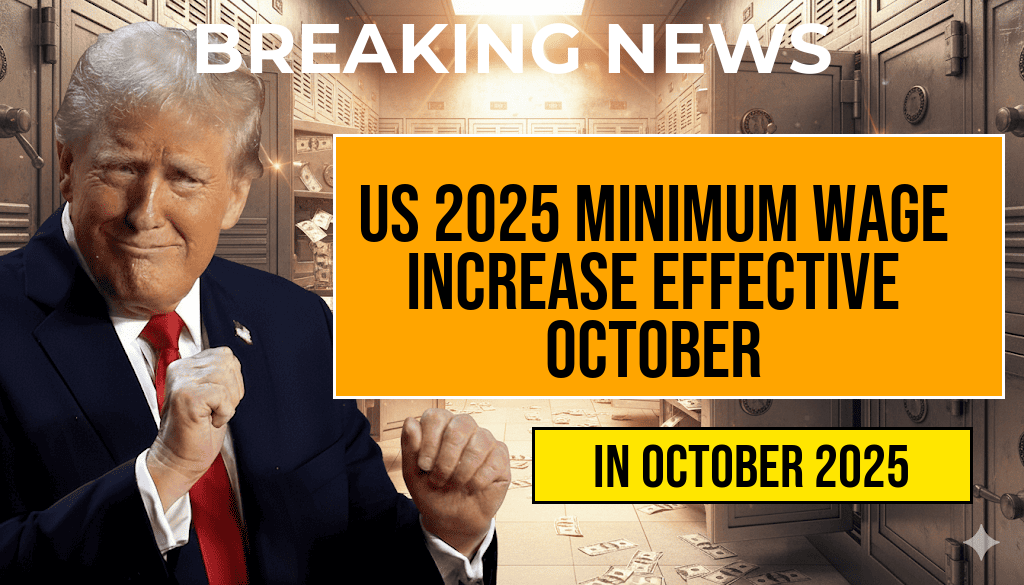The United States will see a significant update to its federal minimum wage effective October 4, 2025, marking a shift in labor and economic policy nationwide. While the federal minimum wage remains at $7.25 per hour since 2009, several states and localities have implemented their own increases over recent years. The upcoming federal adjustment aims to reflect economic conditions, inflation rates, and congressional policy decisions, although the specific new federal rate has yet to be finalized as of this announcement. Nonetheless, many employers across the country, especially those in regions with upcoming state-level increases, will need to adjust payrolls accordingly. This change is poised to impact millions of workers, small businesses, and economic planning efforts in the months ahead.
Background on Federal Minimum Wage Policy
The federal minimum wage is established by the Fair Labor Standards Act (FLSA) and sets the baseline compensation employers must provide for covered workers. Since its last increase over a decade ago, there has been ongoing debate over whether to raise this rate to keep pace with inflation and rising living costs. Despite proposals from various lawmakers, legislative action has been stalled at the federal level, leading to a patchwork of state and local minimum wages that often surpass the federal baseline.
State and Local Minimum Wage Increases in 2025
As of 2025, several states have already announced or enacted scheduled increases to their minimum wages, often tied to inflation or specific legislative timelines. Notable among them are:
- California: Increasing to $16.00 per hour by January 2025 for large employers.
- New York: Raising to $15.75 statewide, with some localities like New York City reaching $16.00.
- Florida: Growing to $12.00 per hour effective September 30, 2025.
- Illinois: Increasing to $14.00 per hour for large employers, phased in over the year.
Localities such as Seattle, San Francisco, and Boston also have their own scheduled increases, often exceeding the federal minimum wage, which highlights regional disparities in wages across the country.
Expected Federal Wage Adjustment for 2025
While the official federal minimum wage for 2025 has not yet been announced, experts and industry analysts project an adjustment based on inflation trends and legislative discussions. Many anticipate an increase to around $9.00 to $10.00 per hour, aligning with the Consumer Price Index (CPI) and economic recovery efforts. However, some policymakers advocate for a more substantial raise to better support low-income workers, citing inflationary pressures that have eroded purchasing power over the past decade.
Legislative and Policy Factors
The Biden administration has expressed support for gradually increasing the federal minimum wage to $15.00 per hour, although legislative gridlock has prevented this from passing into law. The upcoming adjustment is viewed by observers as a compromise to meet economic realities while maintaining political viability. Discussions continue in Congress regarding broader proposals that could influence future increases, including tying minimum wage adjustments directly to inflation or economic indicators.
Impact on Employers and Employees
| Wage Level | Effective Date | Impacted Sectors | Notable Regions |
|---|---|---|---|
| $9.00 – $10.00 | October 4, 2025 | Retail, Hospitality, Healthcare | Federal baseline, certain states |
| Above federal minimum | Varies by state/locality | Technology, Education, Public service | California, New York, Illinois, others |
For employers, especially small businesses, the wage increase may necessitate adjustments in payroll, staffing, and pricing strategies. Workers earning at or near the current federal minimum are expected to see a boost in income, which could influence consumer spending patterns and local economic activity.
Broader Economic Context
The wage hike comes amid ongoing economic recovery efforts following disruptions caused by the COVID-19 pandemic. While higher wages can improve worker well-being and reduce income inequality, there is also concern about potential impacts on employment levels, especially for low-skilled positions. Economists remain divided on the long-term effects, with some emphasizing the benefits of increased consumer purchasing power, and others cautioning about possible inflationary pressures and business costs.
Next Steps and Public Response
The Department of Labor is expected to issue an official notice detailing the new federal minimum wage shortly before October 4. Employers and workers are advised to monitor updates from federal agencies and state labor departments to ensure compliance. Advocacy groups and labor unions have welcomed the adjustment, viewing it as a step toward a more equitable wage structure. Conversely, some business associations have expressed concern over increased operational costs and calls for delayed implementation.
For comprehensive information on minimum wage laws and updates, visit the Wikipedia page on minimum wage in the U.S. and the Forbes website.
Frequently Asked Questions
What is the new minimum wage rate effective October 4, 2024?
The U.S. minimum wage has increased to an updated hourly pay rate that varies by state and locality, effective October 4, 2024. Please check your specific state or city for the exact rate.
Which states or cities have the highest minimum wages in 2025?
States and cities such as California, Washington, and Seattle are among those with the highest minimum wages in 2025, often exceeding the federal minimum wage to reflect local economic conditions.
How will the minimum wage increase affect workers and employers?
The wage increase aims to boost earnings for low-income workers while potentially impacting business costs. Employers may need to adjust budgets and staffing to accommodate the new pay rates.
Are there any exceptions or special rules for certain industries or employee types?
Yes, some industries and employee categories, such as seasonal workers or tipped employees, may have different wage standards. It’s important to review specific regulations applicable to your sector.
Where can I find the precise minimum wage rate for my location?
You can find the updated minimum wage rates for your area by visiting official state or local government websites or consulting the U.S. Department of Labor resources.

Leave a Reply